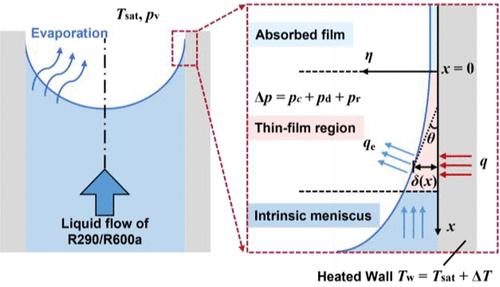第四代制冷剂在纳米/微通道中的蒸发换热特性
IF 3.9
2区 化学
Q2 CHEMISTRY, MULTIDISCIPLINARY
引用次数: 0
摘要
第四代制冷剂的特点是其超低的全球变暖潜能值(GWP),可忽略不计的臭氧消耗潜能值(ODP)和优越的热物理性能。这些优点激发了人们对其应用的兴趣,R290和R600a等烃类替代品正成为特别有前途的选择。然而,这些下一代制冷剂的蒸发传热性能仍然没有得到充分的探索,特别是在小型化的热管理系统中。本文采用接触线传热理论,系统地研究了第四代制冷剂在纳微通道中的蒸发换热特性。我们将R290和R600a的换热性能与第三代制冷剂R134a进行了比较。结果表明,R290和R600a是纳米/微通道蒸发应用的有效生态友好替代品。在此基础上,我们设计了一种微纳复合灯芯蒸发器,由用于蒸发的纳米通道膜和底层微通道供液结构组成。使用R290和R600a作为工作流体确定了最大化设备级热流的最佳通道尺寸。本研究阐明了第四代制冷剂在纳米/微通道中的蒸发换热机理,为纳米通道蒸发器的设计和优化提供了基础见解。本文章由计算机程序翻译,如有差异,请以英文原文为准。

Evaporation Heat Transfer Characteristics of Fourth-Generation Refrigerants in Nano/Microchannels
Fourth-generation refrigerants are characterized by their ultralow global warming potential (GWP), negligible ozone depletion potential (ODP), and superior thermophysical properties. These advantages have spurred growing interest in their adoption, with hydrocarbon-based alternatives such as R290 and R600a emerging as particularly promising options. However, the evaporation heat transfer performance of these next-generation refrigerants remains insufficiently explored, particularly in miniaturized thermal management systems. In this paper, we systematically investigate the evaporation heat transfer characteristics of fourth-generation refrigerants in nano- to microscale channels using the contact line heat transfer theory. We compare the heat transfer performances of R290 and R600a with those of R134a, a third-generation refrigerant. The results demonstrate that R290 and R600a are effective ecofriendly alternatives for nano/microchannel evaporation applications. On this as a basis, we designed a micro-nano composite wick evaporator, consisting of a nanochannel membrane for evaporation and an underlying microchannel liquid supply structure. The optimal channel dimensions for maximizing device-level heat flux are determined using R290 and R600a as the working fluids. This study elucidates the evaporation heat transfer mechanisms of fourth-generation refrigerants in nano/microchannels, providing fundamental insights for the design and optimization of nanochannel evaporators.
求助全文
通过发布文献求助,成功后即可免费获取论文全文。
去求助
来源期刊

Langmuir
化学-材料科学:综合
CiteScore
6.50
自引率
10.30%
发文量
1464
审稿时长
2.1 months
期刊介绍:
Langmuir is an interdisciplinary journal publishing articles in the following subject categories:
Colloids: surfactants and self-assembly, dispersions, emulsions, foams
Interfaces: adsorption, reactions, films, forces
Biological Interfaces: biocolloids, biomolecular and biomimetic materials
Materials: nano- and mesostructured materials, polymers, gels, liquid crystals
Electrochemistry: interfacial charge transfer, charge transport, electrocatalysis, electrokinetic phenomena, bioelectrochemistry
Devices and Applications: sensors, fluidics, patterning, catalysis, photonic crystals
However, when high-impact, original work is submitted that does not fit within the above categories, decisions to accept or decline such papers will be based on one criteria: What Would Irving Do?
Langmuir ranks #2 in citations out of 136 journals in the category of Physical Chemistry with 113,157 total citations. The journal received an Impact Factor of 4.384*.
This journal is also indexed in the categories of Materials Science (ranked #1) and Multidisciplinary Chemistry (ranked #5).
 求助内容:
求助内容: 应助结果提醒方式:
应助结果提醒方式:


